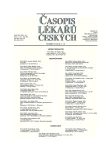Sexually transmitted infections and spermicides
Authors:
Daniel Driák
Authors place of work:
Gynekologicko-porodnická klinika, 1. lékařská fakulta Univerzity Karlovy v Praze a Nemocnice Na Bulovce
Published in the journal:
Čas. Lék. čes. 2012; 151: 459-462
Category:
Přehledový článek
Summary
Incidence of sexually transmitted infections (diseases) has been already increasing again for more than one decade; the world number of 125-340 millions of new cases a year is estimated. Fifteen thousands of new HIV-positive persons daily present a substantial contribution to the total amount. Besides an increasing number of unplanned pregnancies, the huge spreading of sexually transmitted infections predominantly of the second generation is the main reason for a renewed interest in search of local contraceptives, i.e. spermicides. An urgent need for a new, non-detergent, synthetic or natural spermicide emerged to replace the traditional nonoxynol-9. New preparation of microbicidal spermicide should offer dual protection against both unplanned conception and sexually transmitted infections.
Key words:
sexually transmitted infections, sexually transmitted diseases, spermicides, nonoxynol-9, non-detergent compound, antimicrobial peptides.
Zdroje
1. Greenhouse P. Integrated sexual health service. Eur J Contracept Reprod Health Care 2004; 9: 13.
2. Wulff M, et al. The condom in relation to prevention of sexually transmitted infections and as a contraceptive methos in Sweden. Eur J Contracept Reprod Health Care 2004; 9: 69–77.
3. Gregorová P, et al. Antikoncepční chování českých žen: Výsledky národního výzkumu. Čes Gynek 2010; 75: 141–148.
4. Líbalová Z, et al. Vulvovaginitida. Výskyt a význam smíšených a „nezařaditelných” obrazů. Čes Gynek 2007; 72: 32–37.
5. D’Cruz OJ, et al. Clinical development of microbicides for the prevention of HIV infection. Curr Pharm Des 2004; 10: 315–336.
6. Mitchell HS, et al. Contraception choice for HIV positive women. Sex Transm Infect 2004; 80: 167–173.
7. Čepický P, et al. Pohlavní přenos vulvovaginitid. Mod Gynek Porod 2006; 15: 420–423.
8. Unzeitig V. Bariérová a chemická antikoncepce. Mod Gynek Porod 1997; 6: 431–439.
9. Yedery RD, et al. Antimicrobial peptides as microbicidal contraceptives: prophecies for prophylactics –a mini review. Eur J Contracept Reprod Health Care 2005; 10: 32–42.
10. Cone RA, et al. Vaginal microbicides: detecting toxicities in vivo that paradoxically increase pathogen transmission. BMC Infect Dis 2006; 6: 90.
11. Gupta G. Microbicidal spermicide or spermicidal microbicide? Eur J Contracept Reprod Health Care 2005; 10: 212–218.
12. Aktualizace doporučených postupů CDC pro léčbu pohlavně přenosných chorob. Komentář: Čepický P. Gynek po prom 2003; 3: 32–40.
13. Ingram MJ, et al. A potential anti-implantation and spermicidal strategy: putative derivatives of nonoxynol-9 and anti-inflammatory agents and their spermicidal activity. Eur J Contracept Reprod Health Care 2006; 11: 258–261.
14. Ballagh SA, et al. Safety of single daily use for one week of C31G HEC gel in women. Contraception 2002; 66: 369–375.
15. Witherell GW. Glyminox Biosyn. Curr Opin Invest Drugs 2004; 5: 222–231.
16. Ramalho-Santos J, et al. Modulating sperm function for contraception: a multilayered challenge. Eur J Contracept Reprod Health Care 2012; 17: S6.
17. Kumar L, et al. Imidazole derivatives as possible microbicides with dual protection. Eur J Med Chem 2010; 45: 817–824.
18. Jain A, et al. Novel trichomonacidal spermicides. Antimicrob Agents Chemother 2011; 55: 4343–4351.
19. Weber J, et al. „Chemical condoms“ for the prevention of HIV infection: evaluation of novel agents against SHIV (89.6PD) in vitro and in vivo. AIDS 2001; 15: 1563–1568.
20. Dvořáčková K, et al. Mikrobicidy v lékových formách. Remedia 2008; 18: 181–184.
21. Sitruk-Ware R, et al. Vaginal rings for contraception. Eur J Contracept Reprod Health Care 2012; 17: S12–S13.
Štítky
Adiktologie Alergologie a imunologie Angiologie Audiologie a foniatrie Biochemie Dermatologie Dětská gastroenterologie Dětská chirurgie Dětská kardiologie Dětská neurologie Dětská otorinolaryngologie Dětská psychiatrie Dětská revmatologie Diabetologie Farmacie Chirurgie cévní Algeziologie Dentální hygienistkaČlánek vyšel v časopise
Časopis lékařů českých

- Přerušovaný půst může mít významná zdravotní rizika
- Metamizol jako analgetikum první volby: kdy, pro koho, jak a proč?
- MUDr. Lenka Klimešová: Multioborová vizita může být klíčem k efektivnější perioperační léčbě chronické bolesti
Nejčtenější v tomto čísle
- Sexuálně přenosné infekce a spermicidy
- XIV. kongres mladých otorinolaryngologů s mezinárodní účastí
- Jak číst kriticky odborné články
- Aktuální koncepce ošetření závažných poranění v Traumatologickém centru Fakultní nemocnice Královské Vinohrady
